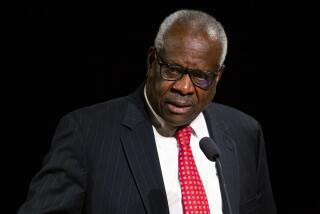Want Political Help? Look to the Courts
- Share via
The big lawsuit is back.
Last week’s decision by an Oregon jury to award $107 million in damages against an antiabortion Web site breaks new ground in the fight to ensure women safe access to legal abortions. A Connecticut anchorwoman’s $8.3-million judgment against a local television station for sexual discrimination may change the way news is delivered. The settlement of tobacco lawsuits has already changed the way cigarettes are sold; last week, the Tobacco Institute, the 40-year-old lobbying arm of the industry, was forced to close its doors. In his State of the Union speech, President Bill Clinton announced that the federal government would bring its own lawsuits against tobacco.
Gun-control activists, frustrated with the pace of legislative action, are fashioning creative lawsuits that, if successful, would limit the sale of guns and perhaps even improve their safety. A jury in one closely watched case in New York began deliberations on Thursday in a lawsuit seeking to hold gun makers responsible for gun deaths. In the absence of a patient bill of rights, juries have been returning record amounts to people suing their health management organizations for denial of treatment.
Big lawsuits are nothing new as a tool of political reform. Following the civil-rights successes in the courts in the 1950s and ‘60s, lawyers began using class-action lawsuits as a tool for restructuring public institutions, from police departments to school systems. Such public litigation, its advocates argued, gave a seat at the table to those whose interests were ignored in a flawed political process.
Instead of being about money, most of these lawsuits sought complex injunctive relief, including continuing supervision by the courts under orders that mandated not only what was to be done, but how. The courts came under criticism for taking on jobs for which they were ill-suited and for being undemocratic, while the increasingly conservative Supreme Court made such cases more difficult to pursue.
In retrospect, even supporters of the old-style public class action would acknowledge that getting black parents and educators on the school board is better than giving them a seat at the back of the courtroom, and that the best way to reform a police department is to have a smart reformer run it. Run for mayor, not for the courthouse.
The new lawsuits making headlines and changing our lives are far simpler. They don’t ask judges to run other institutions; they ask juries for large sums of money. Often, as in the case of the news anchor, the jury awards are larger than what the plaintiff was even seeking, or entitled to receive. The jury is sending a message--what politicians generally ask voters to do.
But the money can be substantial, as well, amounting to a sort of taxation by litigation. Instead of passing a higher tax on cigarettes, the states and federal government force the companies to raise the prices themselves; if the gun litigation is successful, the cost of guns, new and used, should increase, which should decrease demand.
There is, of course, a case to be made that legislatures should be addressing these issues, not juries. If taxes are to be imposed, they should be enacted by representative bodies; if new responsibilities are to be imposed on health insurers, it should be done by Congress. Prevention of violence at abortion clinics should surely be the responsibility of lawmakers, not left to eight people in a jury room, or to a judge appointed for life. Courts, particularly federal courts, are antimajoritarian, undemocratic institutions, which is both their strength and their weakness.
But just as the big lawsuits of past decades could be understood as a direct response to the failures of the political process to represent all the people, so, too, the latest resort to courts to protect public health and safety is a direct response to the capture of the legislative process by those losing the lawsuits. The Oregon lawsuit was brought under an act of Congress passed in 1994, which had, until this case, been invoked only where there were explicit and overt threats to clinics.
Since the GOP took control of Congress in 1995, the abortion agenda has been dominated by those who want to end abortion, not those who provide it. The big fight last year was over banning late-term, so-called “partial birth” abortions, and it took a presidential veto to block the antiabortion forces. The antiabortion position holds sway in Congress to a greater extent than in the country because of the control the religious right exercises over the GOP.
So, too, for tobacco and HMOs, both of which wield the power in Congress to block legislative efforts broadly popular in the country, as was amply demonstrated last year.
In practice, juries often turn out to be more representative and less corrupt than legislative bodies; tobacco companies, the No. 1 donors to the Republican Party, don’t fund campaigns for jurors. Women make decisions on juries in numbers equal to men; in local television, virtually all the decision-makers are men.
Throughout the current scandal season in Washington, there has been a notable disconnect between the attitudes of the Washington elite and those of everyone else in America. While Washington has been consumed by scandal, the country has been looking elsewhere. Increasingly, the important debates and the important victories are taking place in real courtrooms, not in the Capitol’s equivalent.
It may be a measure of the change in the judiciary: Six years of moderate Clinton appointments have begun to blunt the edges of 12 years of very conservative ones. But it is also a measure of the failure of political institutions to address concerns that demand attention.
More to Read
Get the L.A. Times Politics newsletter
Deeply reported insights into legislation, politics and policy from Sacramento, Washington and beyond. In your inbox twice per week.
You may occasionally receive promotional content from the Los Angeles Times.










